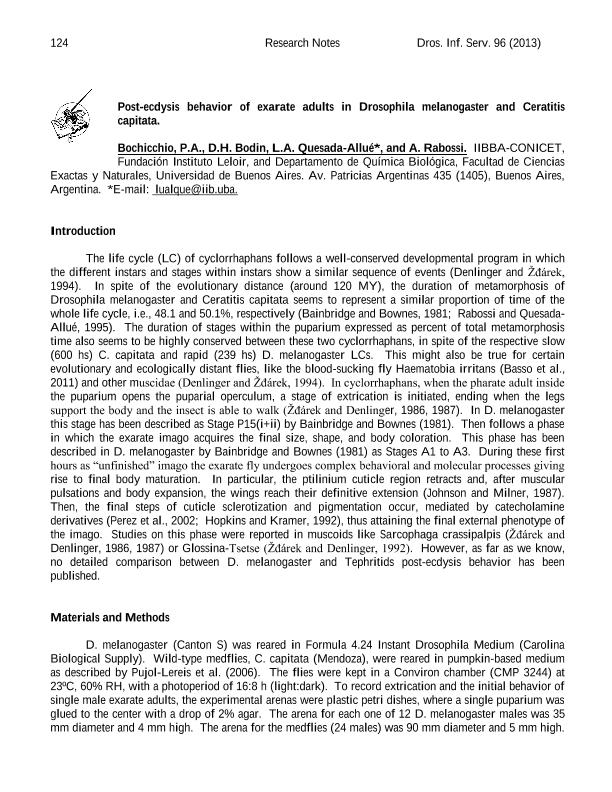Artículo
Post-ecdysis behavior of exarate adults in Drosophila melanogaster and Ceratitis capitata
Fecha de publicación:
12/2013
Editorial:
University of Oklahoma
Revista:
Drosophila Information Service
ISSN:
0070-7333
Idioma:
Inglés
Tipo de recurso:
Artículo publicado
Clasificación temática:
Resumen
The life cycle (LC) of cyclorrhaphans follows a well-conserved developmental program in which the different instars and stages within instars show a similar sequence of events (Denlinger and Žđárek, 1994). In spite of the evolutionary distance (around 120 MY), the duration of metamorphosis of Drosophila melanogaster and Ceratitis capitata seems to represent a similar proportion of time of the whole life cycle, i.e., 48.1 and 50.1%, respectively (Bainbridge and Bownes, 1981; Rabossi and QuesadaAllué, 1995). The duration of stages within the puparium expressed as percent of total metamorphosis time also seems to be highly conserved between these two cyclorrhaphans, in spite of the respective slow (600 hs) C. capitata and rapid (239 hs) D. melanogaster LCs. This might also be true for certain evolutionary and ecologically distant flies, like the blood-sucking fly Haematobia irritans (Basso et al., 2011) and other muscidae (Denlinger and Žđárek, 1994). In cyclorrhaphans, when the pharate adult inside the puparium opens the puparial operculum, a stage of extrication is initiated, ending when the legs support the body and the insect is able to walk (Žđárek and Denlinger, 1986, 1987). In D. melanogaster this stage has been described as Stage P15(i+ii) by Bainbridge and Bownes (1981). Then follows a phase in which the exarate imago acquires the final size, shape, and body coloration. This phase has been described in D. melanogaster by Bainbridge and Bownes (1981) as Stages A1 to A3. During these first hours as “unfinished” imago the exarate fly undergoes complex behavioral and molecular processes giving rise to final body maturation. In particular, the ptilinium cuticle region retracts and, after muscular pulsations and body expansion, the wings reach their definitive extension (Johnson and Milner, 1987). Then, the final steps of cuticle sclerotization and pigmentation occur, mediated by catecholamine derivatives (Perez et al., 2002; Hopkins and Kramer, 1992), thus attaining the final external phenotype of the imago. Studies on this phase were reported in muscoids like Sarcophaga crassipalpis (Žđárek and Denlinger, 1986, 1987) or Glossina-Tsetse (Žđárek and Denlinger, 1992). However, as far as we know, no detailed comparison between D. melanogaster and Tephritids post-ecdysis behavior has been published.
Palabras clave:
Ecdisis
,
Díptero
,
Ciclorrafos
Archivos asociados
Licencia
Identificadores
Colecciones
Articulos(IIBBA)
Articulos de INST.DE INVEST.BIOQUIMICAS DE BS.AS(I)
Articulos de INST.DE INVEST.BIOQUIMICAS DE BS.AS(I)
Citación
Bochicchio, Pablo Alejandro; Bodin, Diego H.; Quesada Allue, Luis Alberto; Rabossi, Alejandro; Post-ecdysis behavior of exarate adults in Drosophila melanogaster and Ceratitis capitata; University of Oklahoma; Drosophila Information Service; 96; 12-2013; 124-127
Compartir




